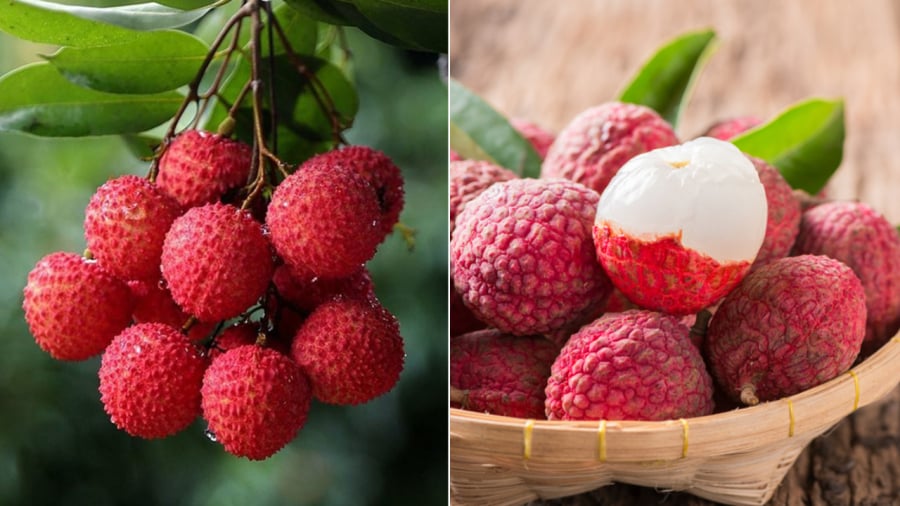Lychee was considered a precious fruit in ancient times. Only royalty and nobility had the privilege of indulging in this delicacy. Lê Quý Đôn, a renowned scholar, described the lychee in his book, Vân Đài Loại Ngữ, as having an exterior like “silken rose and purple thread,” and flesh akin to “crystal and falling snow.”
Lychees (also known as lei chi) are small, round fruits with a bumpy outer skin. When ripe, their shell turns a reddish-purple, revealing white, juicy flesh that surrounds a dark brown seed. The fruit is sweet, and when dried, its sweetness intensifies with a subtle tangy note. Fresh lychees are best enjoyed straight off the tree, but they also lend themselves well to a myriad of culinary creations, including ice cream, desserts, beverages, and even wine. They can be stored in the refrigerator for 5-10 days and, when dried, can last for up to a year if properly stored.
In traditional medicine, lychees are believed to possess warming properties. The fruit is said to benefit the heart, strengthen the spleen and liver, nourish the blood, support the kidneys, quench thirst, and boost energy. Modern scientific research has revealed that lychees are packed with water, dietary fiber, vitamins, and antioxidants such as rutin and epicatechin. These compounds offer a host of health benefits, including improved digestion, enhanced immunity, anti-aging effects, and skin-nourishing properties.
While lychees are a delicious treat, they should be enjoyed in moderation as they can cause a spike in blood sugar levels and may lead to heatiness and skin eruptions if consumed in excess.

To prevent any adverse effects from overconsumption, keep these tips in mind:
Avoid Eating Too Many Lychees at Once
Lychees are high in natural sugars. Consuming more than 500 grams (about 10-12 lychees) in one sitting can lead to a rapid increase in blood glucose levels, overwhelming the liver’s ability to process it. This, in turn, triggers the release of excess insulin to lower blood sugar, resulting in symptoms such as rapid heartbeat, headache, dizziness, nausea, sweating, and fatigue.
It is recommended that adults limit their intake to around 10 lychees per serving, while children should have no more than 3-4.
Individuals with diabetes should be particularly cautious as the high fructose content of lychees can cause a significant rise in blood sugar levels, posing serious health risks.
Soak Lychees in Salted Water Before Consumption
Some people experience adverse reactions such as nausea, hives, vomiting, abdominal pain, diarrhea, difficulty breathing, and low blood pressure after eating lychees. While the fruit itself is not the culprit, a toxic mold called Candida tropicalis may be to blame. This fungus tends to grow on overripe, bruised, or decaying lychees, thriving on the fruit’s high sugar content and acidic environment.
To minimize the risk of consuming contaminated fruit, rinse lychees thoroughly and soak them in salted water to help remove any harmful substances and inhibit the growth of pathogens.
Individuals Who Should Avoid Lychees
Due to their high sugar content, lychees are not recommended for individuals with diabetes or those experiencing high blood sugar levels. The surge in blood glucose that comes from consuming large quantities of lychees can have detrimental effects on health.
Those who are overweight or obese should also exercise moderation when it comes to lychees, as the fruit’s natural sugars can contribute to weight gain and excess body fat.
Pregnant women should approach lychees with caution as well. The high sugar content can impact both the mother and the developing fetus, leading to a spike in blood sugar levels. Women with gestational diabetes, in particular, should limit their intake of this fruit.
The Hidden Treasure of the Sea: How This Fish’s Roe Rivals Bird’s Nest and Ginseng in Value
“In the past, not many paid attention to the nutritional value of this particular fish part. But now, it has evolved into a prized commodity. This once-overlooked piece of the piscine puzzle is now a sought-after delicacy, with a unique flavor profile and an impressive nutrient roster. It is time to uncover the hidden treasure that is [name of fish product].”






































